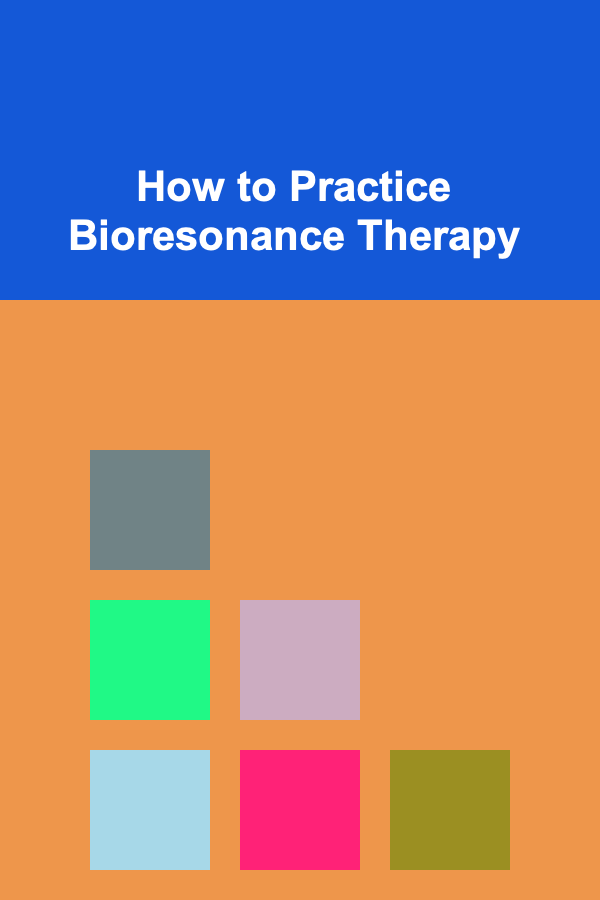
How to Practice Bioresonance Therapy
ebook include PDF & Audio bundle (Micro Guide)
$12.99$11.99
Limited Time Offer! Order within the next:

Bioresonance therapy is a holistic, non-invasive approach to healthcare that works by identifying and correcting imbalances in the body's electromagnetic frequencies. Often considered a form of energy healing, it is based on the premise that every living organism emits electromagnetic waves that can be measured and influenced. This therapy has grown in popularity due to its promise to address a wide range of physical and mental health issues, from chronic pain to emotional disturbances, without the use of drugs or surgery.
This article provides an in-depth guide on how to practice bioresonance therapy, its principles, techniques, and applications, and the tools needed to become proficient in its use.
What is Bioresonance Therapy?
Bioresonance therapy is founded on the concept that every cell, organ, and even individual pathogens in the human body has a unique electromagnetic frequency. These frequencies can become disrupted due to various factors such as illness, stress, or environmental toxins. By detecting these imbalances, bioresonance practitioners aim to realign the body's electromagnetic field and restore balance.
The practice combines elements of traditional Chinese medicine, energy healing, and modern technological advances in bioenergetics. Bioresonance practitioners use specialized equipment, such as bioresonance devices, to scan and analyze the frequencies emitted by the body and apply corrective signals through electrical impulses or magnetic fields.
The therapy itself has been used to treat a wide array of conditions, from allergies, autoimmune disorders, and infections to stress, digestive issues, and sleep disturbances. It is also used to improve general well-being, promote detoxification, and enhance mental clarity.
Core Principles of Bioresonance Therapy
Before diving into how to practice bioresonance therapy, it is essential to understand the fundamental principles that underpin this method:
- The Body's Electromagnetic Field: According to bioresonance theory, the human body is made up of cells that emit electromagnetic waves. These waves can be disrupted by factors like illness, environmental influences, or stress, causing energy imbalances that manifest as physical or emotional symptoms.
- Frequency and Energy Flow: Health is considered a state of harmony and balance between the body's frequencies. Disruptions in these frequencies are thought to contribute to disease and discomfort. Bioresonance aims to restore balance by applying frequencies that can either neutralize or strengthen these disrupted energies.
- Biofeedback Mechanism: Bioresonance therapy operates on the principle of biofeedback, where the body's own energy frequencies are detected, interpreted, and then adjusted. The idea is that by using electromagnetic waves that correspond to the body's natural frequencies, the body will adjust its own energy field toward a more balanced state.
- Holistic Approach: One of the key features of bioresonance therapy is its holistic approach, treating the whole body and mind rather than just addressing the symptoms of a disease or imbalance. This treatment modality recognizes that physical, emotional, and environmental factors are interconnected and influence one another.
Tools and Equipment for Practicing Bioresonance Therapy
Bioresonance therapy requires specialized tools and equipment to detect and treat imbalances in the body's frequencies. The most common tools include:
1. Bioresonance Devices
Bioresonance devices are the cornerstone of bioresonance therapy. These devices use sensors to detect the electromagnetic frequencies emitted by the body, analyze them, and identify any imbalances or disruptions. Once these imbalances are detected, the device sends corrective frequencies back to the body to help restore balance.
These devices come in various forms, ranging from handheld units to more advanced systems used in professional clinical settings. Some well-known bioresonance devices include:
- BICOM: A widely used bioresonance system that helps diagnose and treat a range of conditions by scanning the body's energy patterns.
- MORA Therapy Device: A device that uses bioresonance to treat both physical and emotional issues by sending electromagnetic waves to the body.
- TimeWaver: An advanced bioresonance system that works on both the informational and energetic levels of the body.
2. Electrodes and Sensors
To measure the body's electromagnetic frequencies, bioresonance devices use electrodes and sensors. These electrodes are typically placed on the skin, usually on the hands, feet, or head. They help in detecting the body's energy field and allow the device to read the frequencies emitted by different organs and systems in the body.
3. Software and Applications
Many bioresonance systems are supported by advanced software that helps to track and monitor the progress of the treatment. These applications can generate detailed reports based on the body's energy readings, offering insights into possible imbalances and suggesting potential remedies.
4. Homeopathic Remedies and Frequency Programs
While bioresonance devices are the main tools used to detect and balance the body's frequencies, some practitioners also incorporate homeopathic remedies or frequency-based treatments. These remedies can be programmed into the device or prescribed separately to enhance the therapeutic effects of bioresonance therapy.
How to Practice Bioresonance Therapy: A Step-by-Step Guide
The process of practicing bioresonance therapy involves several key steps, from conducting an initial assessment to delivering the treatment. Below is a step-by-step guide on how to perform a bioresonance session:
1. Initial Consultation and Assessment
The first step in practicing bioresonance therapy is a thorough consultation with the patient. This step involves gathering information about the patient's medical history, symptoms, lifestyle, and emotional well-being. The practitioner may ask about any existing conditions, recent stresses, or environmental factors that could contribute to energy imbalances.
During this consultation, the practitioner will explain the bioresonance process and what to expect during the treatment. It's essential to establish a rapport with the patient and ensure they feel comfortable throughout the process.
2. Testing and Scanning the Body's Frequencies
After the initial consultation, the practitioner will proceed with scanning the patient's body to detect any energetic imbalances. The patient will be asked to sit comfortably while electrodes or sensors are placed on their skin. These sensors will pick up the electromagnetic frequencies emitted by the body's organs, tissues, and cells.
The bioresonance device will analyze the frequencies and identify any areas where imbalances exist. These imbalances may be associated with physical ailments, emotional blockages, or even environmental stressors. Some devices provide detailed feedback on these imbalances, categorizing them by organ system, pathogen, or emotional state.
3. Frequency Analysis and Diagnosis
Once the frequencies are scanned, the device will produce a detailed analysis of the body's energetic field. This diagnostic step is critical for understanding which parts of the body require attention. The analysis may include identifying:
- Organs or systems that are out of balance (e.g., digestive, respiratory, immune system)
- Infections or pathogens that could be disrupting the body's frequencies
- Emotional imbalances such as stress, anxiety, or depression
- Toxins or environmental stressors affecting the energy field
The practitioner will then interpret the results and develop a treatment plan based on the imbalances identified. This plan will outline the specific frequencies that need to be applied to restore balance to the patient's energy field.
4. Treatment and Frequency Application
In the treatment phase, the practitioner will apply corrective frequencies to the patient's body. This is done using the bioresonance device, which transmits specific electromagnetic signals to the body. These frequencies aim to neutralize harmful frequencies, strengthen weak areas, and promote healing.
The practitioner may use different methods to deliver the treatment:
- Direct Transmission: The device can send corrective frequencies directly into the body via electrodes attached to specific points on the skin.
- Indirect Transmission: In some cases, frequencies can be transmitted through the air or by placing the device near the patient's body.
- Frequency Programs: Some devices allow practitioners to use pre-programmed frequency patterns that are designed to address specific conditions, such as chronic pain, allergies, or stress.
The treatment duration varies depending on the patient's condition and the severity of the imbalances. Sessions typically last anywhere from 30 minutes to an hour.
5. Monitoring Progress and Follow-Up
After the initial treatment, the practitioner will monitor the patient's progress over time. Regular follow-up appointments are necessary to track the effectiveness of the therapy and make any necessary adjustments. In some cases, the practitioner may adjust the frequency settings or add additional treatments, such as homeopathic remedies or supplements, to support the healing process.
Bioresonance therapy is often delivered in multiple sessions, with the number of treatments varying based on the patient's condition. Chronic conditions may require more frequent sessions, while acute issues might resolve in fewer treatments.
6. Lifestyle and Self-Care Recommendations
In addition to bioresonance therapy, practitioners often provide lifestyle and self-care recommendations to help support the healing process. These may include suggestions related to diet, exercise, stress management, and environmental changes. A holistic approach that addresses the root causes of imbalances can enhance the overall effectiveness of the treatment.
Benefits and Applications of Bioresonance Therapy
Bioresonance therapy offers a range of benefits, including:
- Pain Relief: By restoring balance to the body's energy field, bioresonance can help alleviate chronic pain and discomfort.
- Detoxification: The therapy can support the body in eliminating toxins and environmental stressors, which can improve overall health.
- Stress Reduction: By addressing emotional blockages and imbalances, bioresonance can help reduce stress, anxiety, and depression.
- Immune System Support: Bioresonance can help strengthen the immune system by identifying and correcting energy imbalances related to infections or pathogens.
- Enhanced Well-Being: Many patients report feeling more energized, balanced, and emotionally centered after bioresonance therapy.
Bioresonance therapy is used to treat a wide range of conditions, including:
- Allergies
- Chronic pain
- Digestive disorders
- Autoimmune diseases
- Stress and anxiety
- Skin conditions
- Sleep disturbances
Conclusion
Bioresonance therapy is an innovative and holistic approach to healing that works by identifying and correcting imbalances in the body's electromagnetic frequencies. With the right tools, knowledge, and practice, bioresonance practitioners can offer effective treatments for a variety of physical, emotional, and mental health conditions.
By following the steps outlined in this article and incorporating the core principles of bioresonance therapy, practitioners can help their patients restore balance and enhance overall well-being. However, as with any therapeutic modality, it is important to approach bioresonance with an open mind, a willingness to learn, and a deep respect for the body's innate ability to heal itself.

How to Clean Your Windows Like a Professional
Read More
How to Create Profitable Passive Income Streams through Deep Learning Algorithms
Read More
How To Eliminate Distractions for Deep Work
Read More
How to Optimize Your Dropshipping Workflow to Minimize Customs Delays
Read More
How to Run LinkedIn Polls and Surveys to Understand Your B2B Dropshipping Audience
Read More
How to Use Magnetic Strips to Organize Scissors and Tools
Read MoreOther Products

How to Clean Your Windows Like a Professional
Read More
How to Create Profitable Passive Income Streams through Deep Learning Algorithms
Read More
How To Eliminate Distractions for Deep Work
Read More
How to Optimize Your Dropshipping Workflow to Minimize Customs Delays
Read More
How to Run LinkedIn Polls and Surveys to Understand Your B2B Dropshipping Audience
Read More